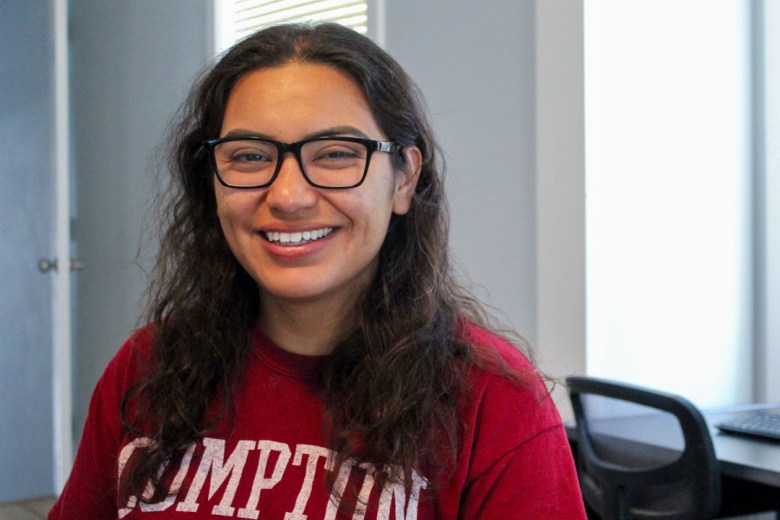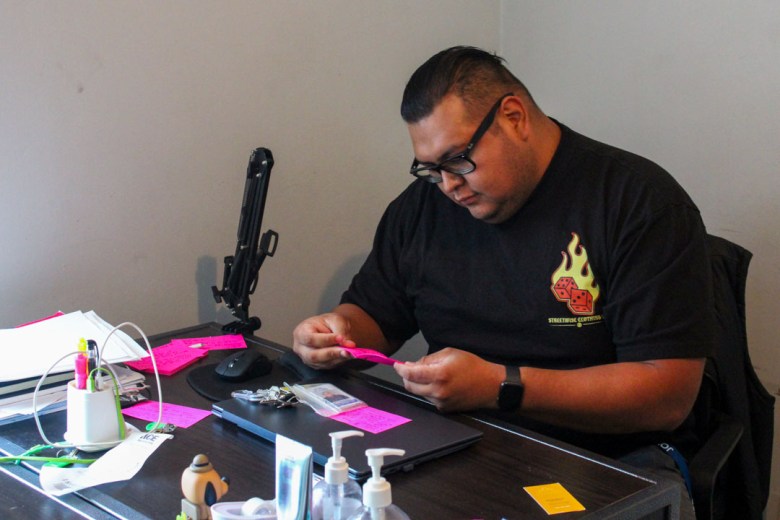LOS ANGELES — Citrus College was Kyshawna Johnson’s third attempt at higher education.

She first enrolled in a community college at age 18 while living with her grandmother, who was her foster care guardian. But the house was too chaotic to focus on studies, and without support, Johnson dropped out. She gave it another go at 19, but said when foster care support money stopped, she was forced to leave her grandmother’s house and college.
Her aunt and uncle offered her a room in 2016, and for nearly eight months, Johnson experienced a stable, calm home. She enrolled again and excelled at Citrus in Glendora. But her housing arrangement didn’t last. All her apartment applications were rejected, even though she could afford the rent from jobs at T.J. Maxx and a movie theater. She bounced from one friend’s couch to another. Then she lived in her car for six months, each night trying to find a parking spot under a streetlight.
“It was just scary,” she said. Her grades fell to Ds, and she thought, “College just may not be for me.”
But before dropping out a third time, Johnson connected with Jovenes Inc., an East Los Angeles nonprofit that helps homeless youth. The organization paid for her to stay in a room in a woman’s house. Finally, she had a place “just to be, and focus.”
For many former foster care students like Johnson — young adults with few resources to navigate independence — housing instability is a major impediment to completing a college degree. Nationally, reports indicate that 20 to 40 percent of youth aging out of foster care lack stable housing. Housing-insecure students take fewer classes, earn fewer credits and are more likely to leave college before graduating, research shows.
California has made significant moves to offer housing assistance to students with foster care experience, yet a comprehensive solution that identifies these students early and offers housing well-suited to their needs remains elusive.

One model gaining popularity is called “college-focused rapid rehousing,” which received $19 million in state funding during the 2022-23 school year across California’s three higher education systems. Sometimes Jovenes master-leases apartments for students to live in while working with a case manager to find a more permanent solution. Other times, as in Johnson’s case, the organization offers a rental subsidy. The goal is to provide a place to live right away and a path to self-sufficiency. For example, at first a participant might pay little or nothing for their living space, then housing costs incrementally increase.
Another fix is dorms. But such housing is a rarity at community colleges, where most former foster care students begin their higher education. With state funding help, several of California’s community colleges have plans to build housing, but space is not specifically dedicated to students from the foster care system.
Advocates say investing in both the Jovenes model and a new type of dorm designed for community college students with foster care experience could significantly change their dim college prospects.
Related: California helps college students cut their debt by paying them to help their communities
Students with foster care backgrounds often must overcome hurdles rooted in their K-12 education. In California, these youth — who disproportionately identify as LGBTQ+ and Black — are more likely to be chronically absent, attend high-poverty schools and experience disruption because of transfers.
Those who do enter college are often less academically prepared and are more likely to require significant financial and mental health support. Like Johnson, they typically work more hours than ideal for a college student.
Among 18-year-old young adults with foster care experience, more than 80 percent said they wanted to complete a degree from a four-year college. But only 4.8 percent had attained that goal four years later, according to the California Youth Transitions to Adulthood Study.
“Housing is probably the number one challenge that foster students face,” said Debbie Raucher of John Burton Advocates for Youth, a California nonprofit that helps youth who have been in foster care or homeless.
A 2015 study found that students who had experienced homelessness were 13 times more likely to have failed college courses and 11 times more likely to have withdrawn from them or failed to register.
Johnson said Jovenes “gave me a chance, and my life turned around.” Her grades shot up to all As. She applied to Oral Roberts University in Oklahoma and received a full scholarship, including housing.
Related: ‘Revolutionary housing’: How colleges aim to support formerly incarcerated students
A major move to disrupt the foster-to-homelessness pipeline at the federal level began with legislation in 2008 that helped states extend foster care services from 18 to 21 years of age.
Since then, California lawmakers have passed a slew of budget expansions and laws to benefit students with foster care experience. In 2009, for example, the state passed legislation requiring many schools to give them priority for on-campus housing. In 2015, the state required some colleges to allow them to stay in dorms over academic breaks for free.
California has also gradually expanded their financial aid and increased funding for campus-based support programs, which include NextUp, Guardian Scholars, and more. Recently, the state increased foster student rent subsidies in higher cost-of-living areas.
But holes remain.

Young people who exited the foster system before age 18, for example, typically don’t qualify for extended services, including a government program that gives housing support through age 24.
For those who qualify for rental subsidies, the California market is so tight that appropriate units, especially close to campus, are rarely available. Plus, students with foster experience struggle to find landlords who will rent to them because they rarely have co-signers, solid credit histories or first and last month’s rent.
Some research suggests that on-campus housing provides the most stable living arrangement for them. But even increased financial aid often doesn’t go far enough to cover all housing costs, said Raucher. Dorms can also be hard socially, because these students tend to be older, and many have children.
This is where Jovenes — and others like it — come in. The organization’s College Success Initiative supports students attending 10 L.A. County colleges. At least 30 percent of Jovenes clients have known foster care experience, said Eric Hubbard, a Jovenes leader.
Jovenes case managers meet with their counterparts on college campuses to give students with foster care experience the support others often get from parents: help connecting with therapists and finding apartments to rent, vouching for them with landlords and financial support.
Academic achievement “skyrockets,” Hubbard said, “once you place someone in an environment where you don’t have to worry about where you’re going to sleep.”
When students at Cerritos College were housed by Jovenes, they became significantly more likely than the rest of the student body to receive a degree in two years and matriculate at a four-year institution, he said.
In 2019, California passed legislation meant to replicate the Jovenes model, and the number of students served has grown.
During the 2021-22 academic year, eight CSU campuses referred students and funneled about $5.2 million to Jovenes and eight other housing providers throughout the state. The program served 1,598 CSU students in 2021-22, up 40% from the year before. Those helped showed a 91% retention or graduation rate, according to a CSU report.
However, the Jovenes model is expensive — roughly $10,000 to $20,000 a year per student according to Hubbard — because it covers not only housing, but also support services and program administration. Another downside is that a significant chunk of money ultimately goes to private landlords.
Some are advocating for community-college based dorms dedicated specifically to students with foster care experience as a more sustainable solution.

Raucher sees cause for optimism. The state recently allocated funds to build subsidized dorms on community college campuses and passed additional legislation to fast-track the effort.
Meanwhile, a bill introduced in the state Senate in February, which is eligible to move forward next year, would amend California’s financial aid programs to guarantee housing for students with foster care experience.
Johnson, who graduated from Oral Roberts with a 3.9 GPA in April 2022, said she is devoted to turning around the lives of students whose experiences she knows all too well.
She accepted a job with Jovenes as a live-in resident manager at one of the larger buildings, and she said she’s trying to be that “one caring adult” research shows is so important to the educational success of students.
This story about Jovenes was produced by The Hechinger Report, a nonprofit, independent news organization focused on inequality and innovation in education. Sign up for the Hechinger newsletter.



